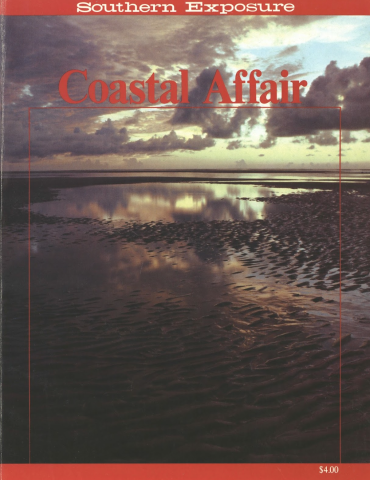Pyrates!

This article originally appeared in Southern Exposure Vol. 10 No. 3, "Coastal Affair." Find more from that issue here.
The following article contains references to sexual assault.
In the early eighteenth century, European ships bound for the West Indies and North American colonies often encountered plundering pirates, including such famous ones as Calico Jack (Jack Rackam), Blackbeard (Edward Teach) and the “gentleman pirate” (Stede Bonnet). Among these outlaws two were exceptional. Their “remarkable ACTIONS AND ADVENTURES” were described at length in Daniel Defoe’s General History of the Pyrates. Both were known for their courage and tenacity in battle. And both were women.
Although born in Ireland, Anne Bonny was raised in colonial Carolina. Her temper flared often, and local rumor claimed she had once killed an English maid-servant with a case knife. When a young man attempted to rape her, she beat him so soundly that according to Defoe, “He lay ill of it for a considerable time.” She moved to the Bahamas after marrying James Bonny, an unemployed sailor. There, in the spring of 1719, she fell in love with Calico Jack Rackam and left her husband for a life of piracy on the high seas.
While sailing with Rackam, Anne Bonny masqueraded as a man, dressing in men’s clothes and fighting alongside the rest of the crew. But it was not long before she found her affections drawn from Rackam to another pirate aboard the vessel. When Bonny at last revealed her sex to the handsome young sailor, she learned to her surprise that her shipmate was actually Mary Read, another woman in disguise. The two became best of friends and sailed together until their capture near the island of Jamaica.
The women’s last stand, in November, 1720, was perhaps their most valiant. According to Defoe, “None kept the Deck except Mary Read and Anne Bonny and one more; upon which, she, Mary Read, called to those under Deck, to come up and fight like Men, and finding they did not stir, fired her Arms down the Hold amongst them, killing one, and wounding others.”
Unlike Anne Bonny, Mary Read had spent most of her life in male garb. She was the illegitimate daughter of an Englishwoman, who had dressed her as a boy to gain financial assistance from relatives. Read spent several years in the British military, serving at various times as a sailor, foot soldier and member of the cavalry. She eventually found herself aboard a Dutch vessel bound for the West Indies, which was captured by Jack Rackam and his pirate crew.
Mary Read joined Rackam’s party and took naturally to life as a pirate. She brazenly defended the trade and its risks, claiming, “That if it was put to the Choice of the Pyrates, they would not have the Punishment less than Death, the Fear of which kept some dastardly Rogues honest; that many of those who are now cheating the Widows and Orphans, and oppressing their poor Neighbours, who have no Money to obtain Justice, would then rob at Sea, and the Ocean would be crowded with Rogues, like the Land, and no Merchant would venture out; so that the Trade, in a little Time, would not be worth following.”
Several weeks after their capture by Jonathan Barret of the British Navy, Anne Bonny, Mary Read and 12 male companions were convicted of piracy. Although all were condemned to hang, the women’s sentences were suspended when the court learned that both were pregnant. Mary Read developed a violent fever and died in prison soon after the trial. Anne Bonny was never executed. When Calico Jack Rackam was admitted to her cell just before his hanging, she had little sympathy to offer. “If he had fought like a man,” she said, “he need not have been hang’d like a Dog.”
Tags
Elizabeth A. Fenn
Elizabeth Fenn is a graduate student in history. She lives in Hillsborough, North Carolina. (1985)